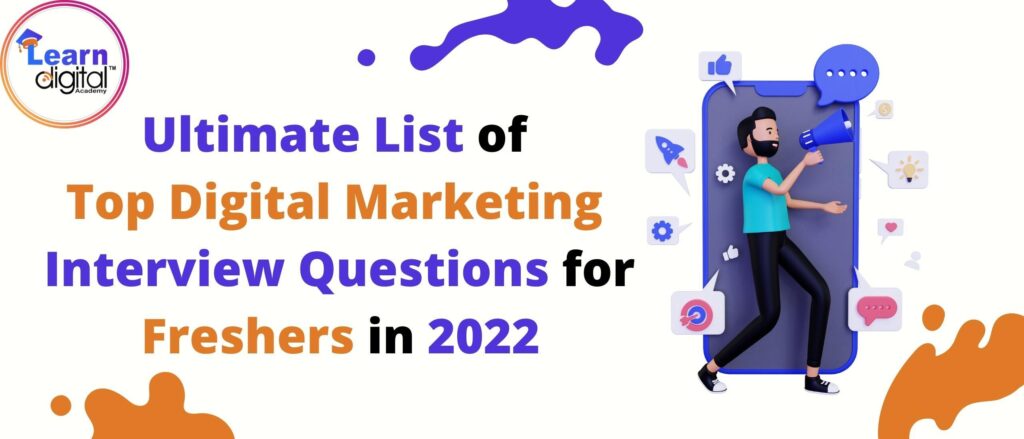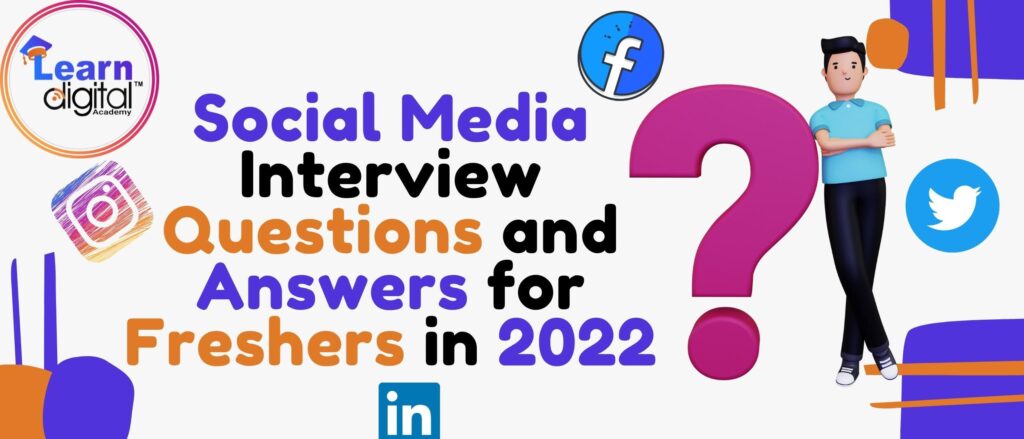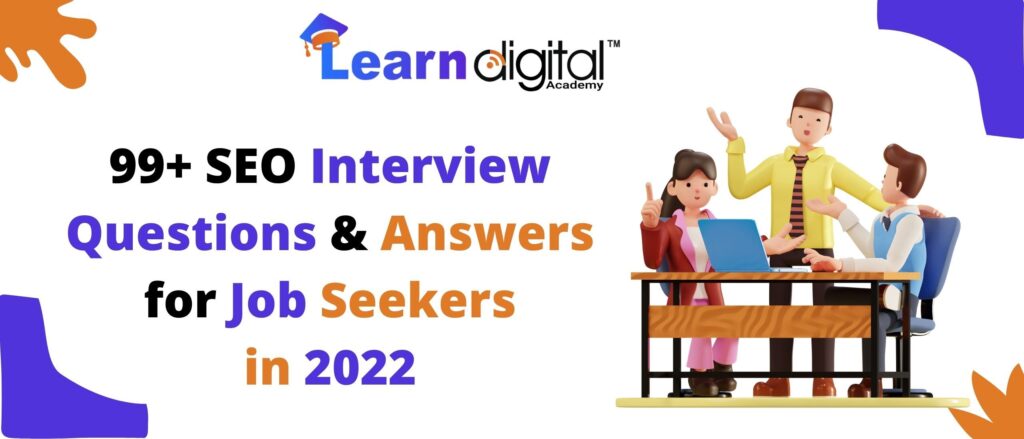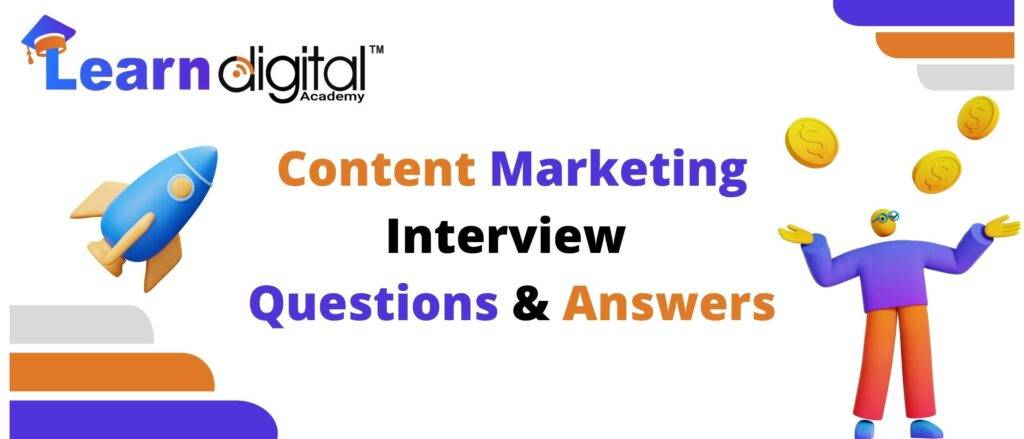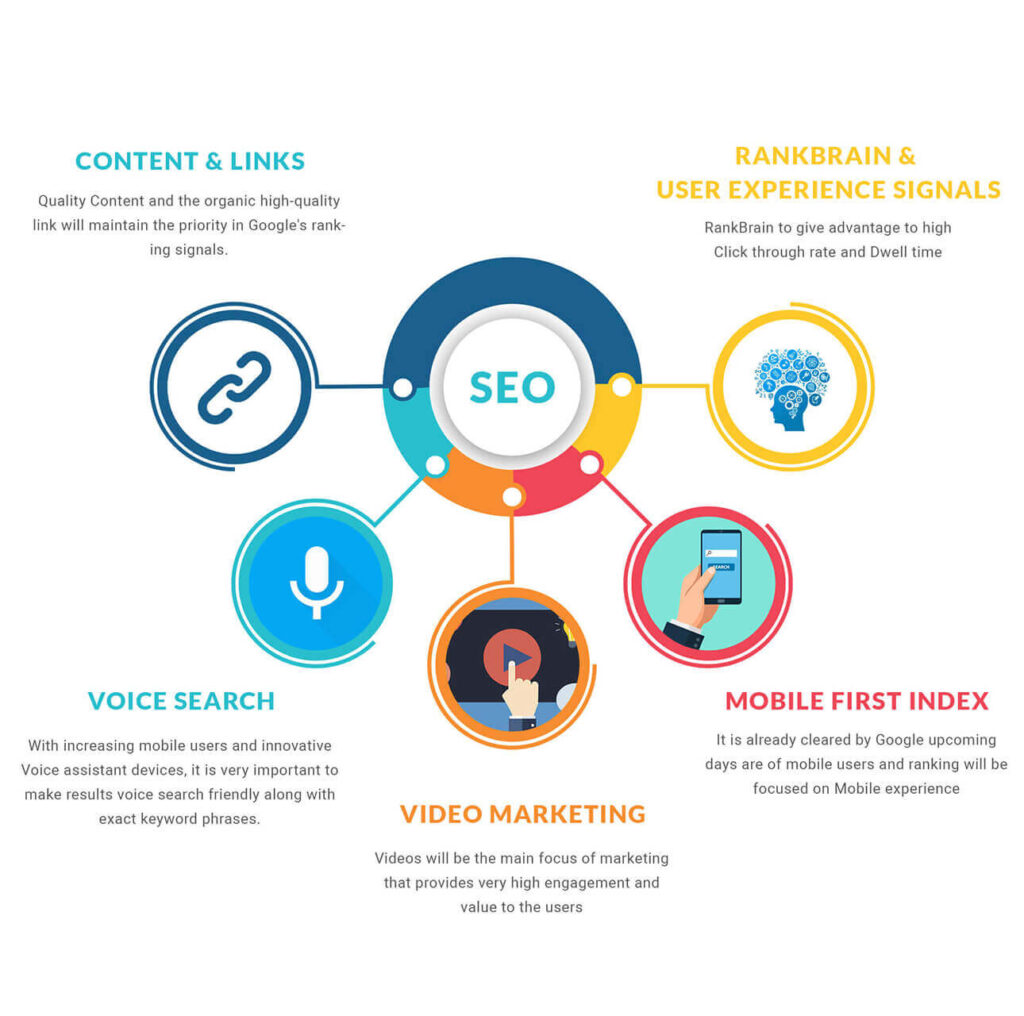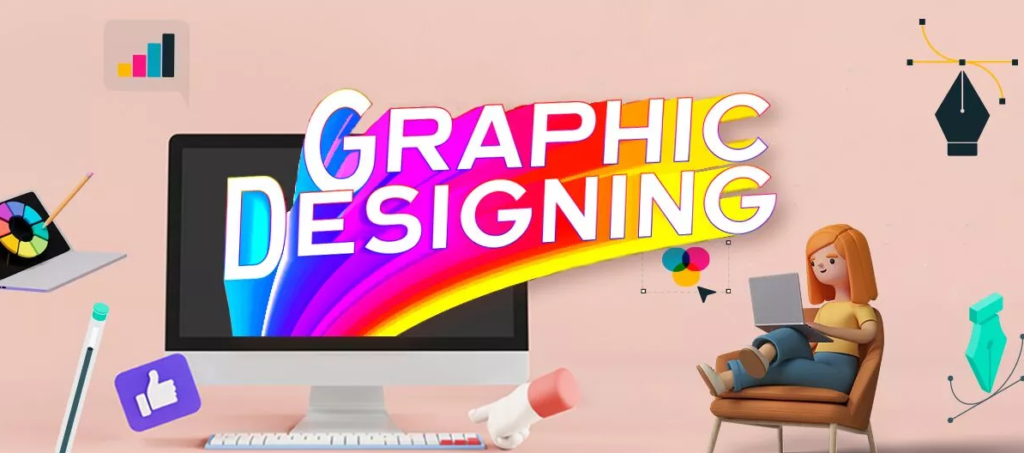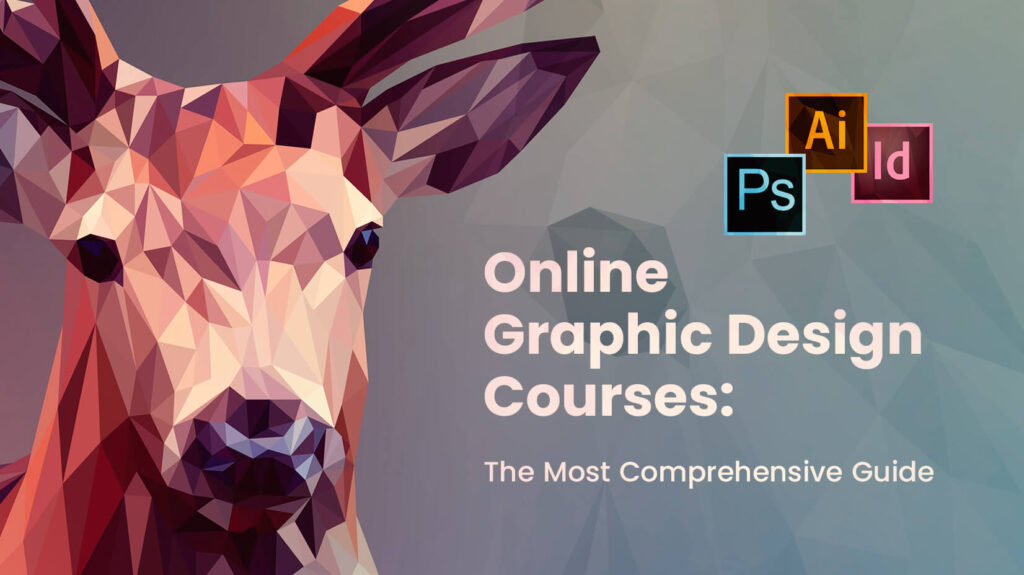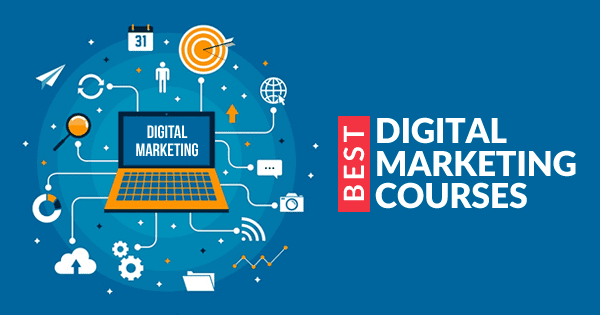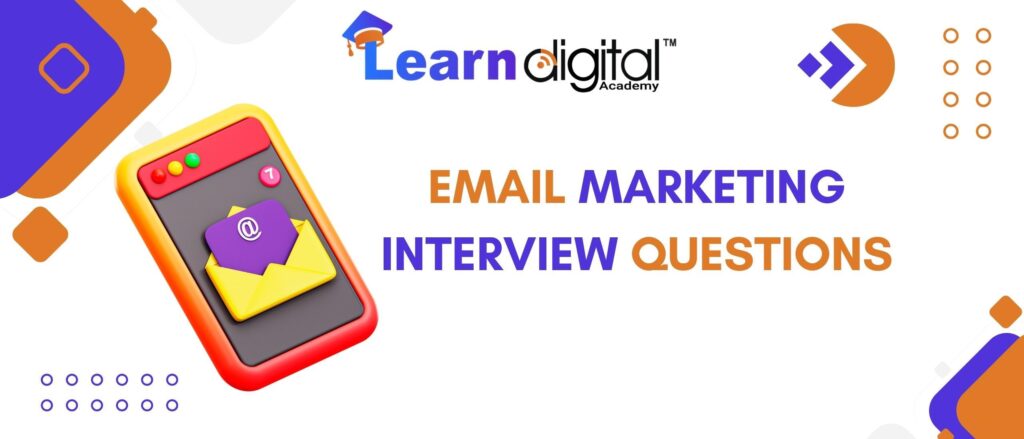
Email marketing has survived the sands of time, and it is still effective decades later. The problems that affect email marketing success are outside of the marketer’s control!
The pressure for improved email design, risks to email deliverability, legislation, and upgrades that obfuscate human engagement, to mention a few.
An organization wanting to employ an email marketing specialist or determine whether you have a solid understanding of email marketing and past experience is likely to ask you interview questions.
These are the Most Popular Email Marketing Interview Questions Answers
1. What methods do you employ to expand your email list?
Ans. Increasing the amount of email addresses you contact with your email campaigns is referred to as growing an email list.
Each marketing email you put out will reach a larger audience, increasing the number of individuals who will open it, improving engagement, and promoting sales conversion.
Many businesses who are new to email marketing or want to expand their consumer base are concerned about growing their email list.
Include at least three tactics you’re familiar with in your response, and try to tie them to the company’s product and target market
Consider the following scenario: “To attract new customers to sign up for the email list, I would start by providing a free offer with each email sign up on the e-commerce site. This is a simple and common method used by many firms in your industry.
Next, I’d rework email marketing to appeal to a younger demographic, who makes up the majority of your target market. Increased content quality can boost engagement.
Finally, I would create incentives such as further discounts for existing users’ friends and relatives to give their email addresses in order to expand our email list.”
2. What is the definition of email marketing?
Ans. Email marketing is a type of marketing that involves sending electronic mail to potential clients in order to establish a relationship.
It’s a type of direct marketing that uses emails to advertise a product or service, with the goal of keeping customers who might be interested in your company well informed.
Also Read: Role of Email Marketing in Business Marketing
3. What role does email marketing play in today’s social media world?
Ans. While there are many social media platforms to choose from, email marketing has a number of advantages over social media marketing. A part of the advantages is.
Drawbacks of Social media: It’s a bit much that your targeted audience is available on a social networking platform.
Because ninety-four per cent of web users use email, your email has a higher chance of being seen than your social networking page.
Customization: Expecting to send customized messages via social media sites is beyond the scope of possibility, however, you may do so via email. It adds a special touch that increases the chances of change.
Target Audience: You can reach out to the correct audience via mailing because you may segment them by age, income, interests, and so on.
Reporting and Analytics: You may examine and detail the open rate, bounce rate, conversions, and click-through rates that the email provides.
Opt-in email: This is the email that is sent to the receiver once he or she has given his or her permission. The response or change rate is higher here, indicating that you care about the recipient’s privacy.
4. Describe a successful email campaign in which you participated.
Ans. It isn’t much else I can say about this! In your ‘back pocket,’ you should always have an example use case.
Discuss the email campaign’s purpose (why you conducted it), the target audience (who it was for), and the components involved (email, eg. landing pages, e-commerce).
Which metrics did you keep track of? How did you do in terms of the metrics you specified (your objectives)?
5. How can you stay on top of the most recent email marketing trends?
Ans. There are a plethora of information sources available to email marketers that want to stay current. Reading blogs and watching videos on YouTube – It all starts with industry tech expertise, so do your homework.
6. What methods do you use to arrange your workload? OR What project management approaches do you use?
Ans. With so many responsibilities and assets to divide among team members, being able to organize your workload is a must-have talent.
You might have utilized a project management application like Asana or Monday to facilitate productive collaboration and guarantee that campaigns are delivered on schedule.
7. Is there a distinction between mailability and deliverability?
Ans. While both mailability and deliverability are ideas that explain why an email can or cannot make it into the recipient’s inbox, there are some differences between the two.
They frequently get mixed up with one another. The terms, however, are distinct in a number of ways.
The Status’ you have with the recipient is referred to as mailability. Is it legal for you to send emails? This may be summed up in a single word: ‘consent.’
Deliverability refers to whether or not you will be able to reach the recipient’s inbox on a specific date/time. Consent does not guarantee that your email will be delivered; there are a number of variables that are out of your control.
You can even use an analogy to demonstrate that you comprehend these two concepts thoroughly, such as the “nightclub analogy.”
8. How do you tell the difference between a hard and a gentle bounce?
Ans. A Soft bounce’ is a temporarily unavailable condition caused by server downtime, the recipient’s inbox being full, or the recipient’s account not being fully set up.
A ‘hard bounce’ is an email address that is permanently undeliverable. Misspelt email addresses and a disabled inbox are two common causes (someone left the company).
Most email marketing solutions will convert a set amount of soft bounces (for example, 5) to a hard bounce, ensuring that emails that bounce frequently do not negatively damage your total deliverability. Here’s where you can learn more about bounces.
9. What is the difference (and examples) between demographic and firmographic data?
Ans. Demographic refers to information about a person. This is the contact-level data in a CRM. Age, gender, and work title are some examples.
Firmographics is a term that refers to information about enterprises (businesses). This is the account-level data in a CRM. Industry and staff count are two examples.
This is useful in B2B marketing and is a key driver of account-based marketing segmentation.
10. What are some examples of different email kinds, and when would you use them?
Ans. Email marketing is more than just “marketing” or “promotional” emails. Other email types include:
Operational:- Examples include service changes and privacy policy updates. To comply with regulations/SLAs, etc., these must be sent regardless of an individual’s mailability status.
Autoresponders are short, usually text-only responses. For instance, after submitting a form, confirmation is required.
11. How would you incorporate landing pages into the campaign’s flow?
Ans. Landing pages are intended to persuade visitors to do the desired action. They should be created in such a way that the desired action is evident and the page is difficult to leave.
The email text serves as a ‘teaser,’ linking to a landing page with more information and, in most cases, a form.
12. Using tracked links or UTM parameters, how would you track the email’s contribution to the overall campaign’s performance?
Although some marketing automation platforms have a tracked links capability, you should stress the value of including UTM parameters in links to track traffic sources to your website and landing pages.
These will show up in Google Analytics reports, and you want “email” to be a major contributor! The source of conversions can also be tracked using UTM parameters.
Adding hidden fields to forms that collect these variables can help you establish that your efforts are paying off. You might also emphasize the significance of developing a UTM naming convention with the entire team in order to keep Google Analytics output tidy.
13. Do you have any experience with drip campaigns? Which scenarios did you go over?
Drip campaigns are a series of emails that follow a set of guidelines for when and if they should be sent. Individuals go at their own pace via the automatic email flow.
Controls are either added by the marketer (for example, waiting two days) or decided by the individual’s behaviour (eg. if the recipient clicks this link, send the next email).
Drip campaigns can be utilized to fuel several stages of the customer experience, including new subscriber welcome, customer onboarding, and “win-back” campaigns. For further examples, check this page.
The interviewer will be interested to learn that you have extensive expertise working in all aspects of the customer journey, not simply the ‘top of funnel’ use cases.
14. Have you set up a preferred email address and/or keep track of consent records?
EPCs can quickly get complicated, especially when numerous business units/product lines and email kinds are involved.
EPCs can quickly get complicated, especially when numerous business units/product lines and email kinds are involved.
It would be useful to discuss how you would organize an email preference centre and how to correctly manage consents (i.e., with the opt-in/opt-out dates noted).
15. How much experience do you have in copywriting?
To “create” that all-important persuasive and engaging email content, email marketing managers should be adept in copywriting.
If copywriting isn’t your strong suit, don’t worry. Talk about how you’re always trying to improve yourself by reading online resources or taking classes (there are tons of free ones available).
16. Describe how you would plan end-to-end account-based marketing campaigns. (if it applies to the company) ?
Describe the processes you’d follow, starting with identifying the most valuable accounts and choosing marketing channels, and ending with aggregating engagement data, analytics, and optimization.
17. Which tool/platform did you use to track the performance of your emails? What metrics did you concentrate on? (Or, if you prefer, whatever behavioural data do you think is most important?)
Ans. Reporting on the success of an email campaign can be done at several levels.
Email marketing solutions have built-in reporting capabilities,
Some companies take their reporting to the next level by using analytics systems like Salesforce’s B2B Marketing Analytics, Tableau, Power BI, or Datorama to create a comprehensive perspective.
18. What are the most crucial metrics to track when it comes to email performance?
Ans. Conversions are crucial in the end – how many people took the desired action? You’ll be able to view the email’s contribution if you use the correct tracking (Qu. 10) method. You should also keep an eye on and be attentive to clicks – but don’t fall into the trap of merely talking about “vanity metrics.”
19. What is the distinction between the click-through rate and the click-to-open rate?
Ans. CTR (click-through rate): the percentage of email receivers who clicked on a link in the email out of all those who got it (delivered)
CTOR (click-to-open rate) is the percentage of email receivers who clicked on a link in the email out of all those who opened it.
The main distinction is that the number of clicks is divided by total delivered (CTR) rather than total opened (TO) (CTOR).
Also Read: List of Digital Marketing Interview Questions Answers
20. What is marketing attribution, and how does it work? (And what is Campaign Influence for Salesforce customers?)
Ans. Marketing attribution entails keeping track of every marketing interaction a customer has with your company.
This is displayed on their record in most marketing automation platforms/CRMs as an activity timeline.’Attribution models’ may appear scary, but they aren’t.
Attribution models govern how revenue from the won business is allocated and should be divided among each touchpoint (campaign).
Models establish ‘rules of thumb’ for how touchpoints are weighted based on their importance (first-touch, last-touch, even distribution), which determine marketing ROI in the end.
Campaign Influence in Salesforce does what I just described – how Salesforce Opportunities are associated with the Campaigns that helped generate them.
It’s all about joining the dots between sales revenue (stored in opportunities) and marketing data (stored in campaigns)
Read a similar article: SEO Interview Questions Answers for Beginners
21. What are some of the most common reasons for unsubscribes and opt-outs? How can you stay away from them? How do you keep track of unsubscribers? What percentage of unsubscribes would be concerning for a single campaign?
Ans. Sending emails too frequently and/or sending emails that aren’t relevant. Worse yet, receivers have no recollection of signing up in the first place!
By being choosy (just sending relevant emails) and putting up an email preference centre, you may avoid unsubscribes (EPC). With an overview report of all dispatched email campaigns, you may discover high unsubscribe patterns.
Unsubscribe rates of more than 0.5 percent are disturbing, while rates of more than 2 percent are alarming.
22. Have you ever changed your strategy as a result of unsubscribers?
Because the question is posed in this manner, you can demonstrate your proactive attitude!
Use one or two of the explanations from the previous answer to describe a modification you made and how it affected unsubscribe rates over time.
You may have dealt with a variety of challenges, so highlighting how you prioritize your efforts is also beneficial. “thumbs up”.
23. Describe some of the methods you use to keep your email databases in good shape?
Ans. You could talk about database hygiene methods like:
- To eliminate incorrect email addresses, email verification is required.
- Cleaning the list to get rid of spam records and dummy data.
- Inactive/unengaged users are archived from the user base, for example, those who haven’t opened an email in 6 months (adjust depending on how often you send emails).
24. What do spam complaints (abuse rate) entail, and how would you deal with them?
Ans. A recipient has stated that your email is unwelcome in their mailbox by filing a spam complaint. This could be due to the fact that they are unfamiliar with the sender, that they have never agreed to receive emails from the sender, or that the email content is unpleasant or bothersome.
Each spam complaint should be handled seriously, as it may have an influence on your email deliverability in the future.
The first thing to look for is which email triggered the complaint, then see if your list segmentation went wrong.
25. What are the biggest obstacles you’ve faced in terms of deliverability, and how did you overcome them?
Ans. Ensure that email authentication is configured correctly (SPF, DKIM, DMARC), Send to smaller email distribution lists (more targeted segmentation).
Keep an eye on the state of deliverability (see next answer)Remove inactive/disengaged users from your send lists and user base.
26. Do you keep track of the status of your deliverability?
Ans. “Yes” should be the answer! Despite your best efforts, deliverability issues can arise unexpectedly and negatively impact the efficacy of your email campaign.
With an overview report of all delivered email campaigns, you can notice poor deliverability. Using services like MX Toolbox, you can also keep track of your email domain’s health and check blacklists.
You might also detail the internal processes you’d put in place if you identified poor deliverability, as well as the measures you’d take to remove the domain from any blocklists.
There’s more you should learn to ensure the interviewer that you’ve got deliverability under control. Check to See If Your Email Domain Is Banned: Here’s How to Deal With It Audit of Email Deliverability: Domain Health Checks in a Flash.
27. What are the most crucial features of an email design?
Ans. There are lot of crucial features of an email design.
- Subject line,
- Pre-header (preview text)
- Call to action button, above the “fold”
- Email layout
- Responsive design
- Personalization/dynamic content
- Compliance information in the footer, including physical mailing address, link to one-click unsubscribe/email preference centre.
28. How well-versed in HTML, CSS, and working with interactive email elements are you?
Ans. Be open and honest about your experience. If you’re not being hired for a developer-designer position, you’ll be using drag-and-drop email builders, with only the occasional requirement to alter a bit of HTML.
29. Have you ever built a responsive email from the ground up?
Ans. If you’re not being hired for a developer-designer position, this won’t be a major consideration. Discuss why responsive emails are important and how you used responsive template designs in email marketing platforms.
30. What should you think about when it comes to email accessibility and design?
Ans. Content that is accessible can be used by “those with permanent and temporary disabilities, such as vision loss, speech and mobility issues, hearing loss, cognitive impairments, or even a learning disability!
Shattered arm, can use without experiencing obstacles that obstruct their ability to finish the task at hand” (Image courtesy of Siteimprove) By design, all new websites must be accessible, and existing websites must be updated.
The Web Content Accessibility Guidelines (WCAG) define the standards for websites, and your email content should adhere to them as well.
Colour contrast should be correct, and buttons’ “status” should be conveyed by something other than colour (for example, an “active”/selected button should do something other than change colour). The order of tabbing is reasonable.
31. Before mailing the entire campaign, how would you test an email?
Ans. Send a test email to ensure that all links and personalisation functions are working properly. Rendering tests: create a rendering test to see how your email looks on various devices and email clients.
This is built-in to several email marketing platforms (typically driven by Litmus).
32. What methods would you use to evaluate individual aspects of an email, such as if one call to action button functions better than another? (Or, rephrased: have you used A/B testing, and if so, how did it go?)
Ans. A/B testing entails sending two versions of content (version A and version B) to a small group of people to see which one achieves better results. Is a blue call to action button, for example, more likely to be clicked than a yellow one?
The golden rule is that you should only modify one variable at a time; otherwise, you won’t be able to tell which variable made the difference.
To sum it up:
Choose your variable.
Make a list of potential receivers (two groups, equal number of recipients in each) Keep track of the outcomes.
33. What could trigger spam filters to mark an email as spam?
Ans. There might be multiple reasons for the filter.
- You’re sending a disproportionately large number of emails.
- You’re sending emails to people who aren’t active or engaged.
- In the subject line, you’ve used spam trigger words/phrases.
- You include links to untrustworthy websites.
- Spam screening is built-in to certain email marketing platforms, while others employ an online service.
34. Would you make any changes to this email, and if so, what would you do?
Ans. This one may make you feel as if you’re being questioned. Don’t say “I’m not sure.” Take a look at the template and construct a mental checklist of everything we’ve spoken about in this part.
35. What criteria would you use to decide the optimum time to send emails?
Ans. By segmenting your lists by geographic location, you can send emails during the best times of the day. You should stick to business hours in B2B marketing (8 am to 5 pm).
Trying out email performance at different times of the day.
Send-time optimization is embedded into several email marketing platforms (for example, Pardot’s Einstein Send Time Optimization)
36. What method would you use to figure out the best amount of emails to send?
Ans. This is a test of how you calculate frequency and recency:
- Too many times (in a short period of time) equals frequency.
- Recency = too lately (in a certain time range).
- Consider a group of unsubscribed prospects and consider whether they opted out because they received too many emails.
- Subscribers who are at risk of “marketing fatigue” should be suppressed.
37. What are some ideas for increasing your subscription base?
Ans. Here are several quick tips and tricks you can use to increase the number of subscriptions to your eNewsletter and other email updates
- Creating a landing page for subscriptions.
- Using social media to spread the word about the landing page.
- Subscription forms can be added to current blog material as banners.
- Including a pop-up form when users first arrive on the site, among other things.
38. What threats and possibilities do you see in email marketing?
Ans. If we pick up any business or platform, there is always a positive side and a negative side of it.
- Potential future prospects include:
- Email marketing is a low-cost, high-impact channel.
- Designs will be more engaging if they are sent as an interactive email.
- Those who take the lead with permission-based marketing will triumph.
- Multi-touch attribution, predictive reporting, and increasingly granular reporting.
- Possible future difficulties include.
- Apple MPP, as well as other likely changes, will make email reporting less reliable.
- Spam filters are becoming increasingly ruthless.
- Legislation governing privacy.
- Inboxes are filling up faster than ever.
39. Why did you choose email marketing as your niche?
Ans. It Could be another way this question is asked. Talk about your career path, the first time you encountered email marketing, and how it made you feel.
Tell the interviewer about what “hooked” you; it could be the results of an email campaign, email design, or that you were thrown into organizing an email campaign.
40. What suggestions do you have for our company?
Ans. This is your final opportunity to explain why you are the greatest applicant for the job!
41. I’m not sure how many emails I should send to my customers.?
Ans. Sending communications two to three times a month will provide enough time between messages to prevent spam.
You can also set up a recurring message sending schedule, but keep an eye on the open and withdrawal rates. If you notice a drop in engagement, you should be set up to reduce your letter sending frequency.
42. When is the most efficient time to send emails?
Ans. Early mornings and weekends are the most common responses to such difficult Email Marketing Interview Questions.
It’s worth noting that such days and times are also responsible for the majority of unsubscribes and bounces.To be on the safe side, go on a Wednesday afternoon.
Alternatively, experiment with multiple days and hours to determine the optimal time for your target audience, as each individual, email list, and recipient is unique.
43. What’s the difference between a hard bounce and a soft bounce?
Ans. When an email cannot be delivered to the address to which it was intended, it is referred to as an email bounce.A hard bounce is an email message that has had a permanent delivery failure.
It could be due to an inaccurate or invalid email address, an outdated domain, or something else.A soft bounce is an email that has experienced a temporary delivery problem.
This could be due to a momentary issue with the recipient’s server, such as a full mailbox or incorrectly inputted information email address, etc.
44. What is an email header, exactly?
Ans. There are three components that make up an email:
Envelope: An internal mechanism for enclosing an email.
The header of an email.
Body of the paper: Contents of the Text
The email header is the first part of an email message. It must include information such as the subject of the email, the sender, and the date. Subject and CC are two optional headers that are frequently used.
The date, time, and topic of the email become one of the headers with the body of the email when it is forwarded.
45. What measures are utilized to evaluate the effectiveness of an email campaign?
Ans The metrics are chosen would be determined by the campaign’s objectives. Aside from that, the most often utilized measures to assess the campaign’s success is determined by
Rate of Openness.
Subscription Rate Click Rate.
CTR (Conversion Rate Rate).
CTR (Conversion Rate Rate).
CTR (Conversion Rate Rate).
CTR (Click through Rate)
Increase in referral business as a result of increased website traffic.
46. How do you increase the number of people who subscribe to your email list?
Ans. The success of email marketing is directly proportional to the size of your email list, which is why building an email subscriber list is such an important question for email marketing. The most effective way to grow an email subscriber list is to-
- Creating fantastic email content.
- Educate your current email supporters about the offer and encourage them to forward your messages.
- With a targeted campaign, you can breathe new life into an old email list.
- Make another lead generation offer, like a free eBook or whitepaper, and require visitors to provide their email address in order to receive it.
- Make use of your social media page to promote special offers.
- All around your site, there are links to offers that catch email information exchanges.
- Gather email addresses at random events such as public exhibitions and enter them into your database, for example.
47. What types of Email Marketing Campaigns are there?
Ans. The four sorts of email marketing campaigns that are necessary are listed below. So, let’s get down to business.
The Newsletter:– This is an email campaign that is sent out on a regular basis and keeps your target clients informed about a specific issue.
When it comes to keeping in touch with your frequent clients, newsletters are the ideal alternative because they are effective at generating traffic back to your website.
Marketing Offers: Marketing offers are the best way to get direct reactions. Marketing deals are effective in showcasing your most recent inventory and persuading your target audience to make a buy.
If your campaign offers a discount or other special promotion of your products or services, Marketing Offer email campaigns are the greatest fit because they include a direct CTA for visitors to click through to your website.
Announcement: A new product, feature, or service is announced by email. They’re useful for keeping your customers informed about new product releases.
Event Invitation: The purpose of an event invitation is to raise awareness of your event. These emails are sent to your present and potential consumers to persuade them to attend an event.
48. How do you calculate the email deliverability rate?
Ans. Metrics are a big part of email marketing jobs. As a result, you must be mindful of deliverability as a candidate. It is one of the most often requested interview questions.
The number of emails sent to target clients without failure is known as the email deliverability rate. You can also use the method to compute this: Total emails delivered/ total emails sent.
49. What are the top five points to keep in mind while creating an email checklist?
Ans. List are listed below
- The purpose of the Email
- Expected Response.
- Documents supporting your email should be attached.
- Precise subject line with the complete message.
- Run a spam check and customize the content accordingly.
50. How do I keep my email from being SPAM?
Ans. To avoid your letter ending up in SPAM, take the following steps:
- Never use a bunch of different coloured typefaces.
- Only one exclamation point should be used at a time! In general, refrain from including the phrases “unsubscribe” and “deleted” in the message body.
- Examine your domain name to see if it has been blacklisted.
- Spam filters check how many messages you’re sending at once.
- If you need to send a message to a large number of people, you should use the BCC function.
- Your subject should be no more than 45 characters long.
- In your content/subject, avoid utilizing spam filtering terms, punctuation, or capital characters.
51. What is the CAN-SPAM Act, and how does it work?
Ans. It’s sometimes misunderstood as a law that establishes corporate email standards. The CAN-SPAM Act is a federal law that prohibits the sending of unsolicited.
Never use a bunch of different coloured typefaces.
At any given time, just one exclamation point should be utilized!
In general, avoid using the words “unsubscribe” and “deleted” in the body of the message. Check to discover whether your domain name has been blacklisted.
Anti-spam software:- Check the number of messages you’re sending at the same time. Use the BCC tool if you need to send a message to a big group of people. The amount of persons on your email list who opened your message is referred to as the open rate.
The open rate is usually stated as a percentage, therefore a 40% open rate means that four out of every ten emails delivered to the inbox were opened.
CTRs (Click-Through-Rates):- It will be counted as a click if someone clicks on any of the links in your email.
The click-through rate is expressed as a percentage of the number of recipients who clicked somewhere on your email out of a hundred.If 30 people out of 100 clicked on your link, your CTR would be 30%.
Rate of Unsubscribe:- Unsubscribes are the number of persons who have unsubscribed from your emails. As a result, the unsubscribe rate is defined as the number of persons who unsubscribed from your email message out of 100.
52. What is the difference between a hard bounce and a soft bounce?
Ans. Bounces on Hard Surfaces :
When you send an email to an address that no longer exists, you get a hard bounce. ISPs such as Gmail, Yahoo, and Hotmail keep track of hard bounces, which is why you should never disregard them.
After even one harsh bounce, it’s best to eliminate persons from your list.
Bounces that are soft :
When your email arrives in a full inbox, it is referred to as a soft bounce. When the recipient deletes some of the emails in his mailbox, your email becomes visible.
Explain Complain or abuse rates?
The Complaint or Abuse Rate informs you about the customers who marked your email as spam. A protest rate of more than 0.05 percent should be avoided.
The average rate of abuse is around .02 percent. However, it varies depending on the type of business. You should make the withdrawal interface unmistakable to reduce grumbling rates.
You must consistently be considerate of your fans, regardless of whether they are departing.
53. What is the difference between a forward rate and a churn rate?
Ans. The Forward Rate refers to the number of times someone opens, reads, and then forwards your email message to someone else.
“Referral rates” or “share rates” are other terms for them. Including a social media sharing button in your email message can help you get more people to forward it.
The frequency with which your list grows after unsubscribes, hard bounces, and complaints has occurred is referred to as the churn rate. The typical churn rate is around 25% per year, which means that email lists lose 25% of their users each year.
You’ll need to add 25% new subscribers to your list to keep it the same and equally legitimate.
54. What indicators and actions do you employ to assess a campaign’s success?
Ans. Open Rate, Click Rate, CTR, and conversions are some of the measures.
55. Explain the concept of email marketing segmentation?
Ans. Segmentation is the process where you slice your user base into segments to send emails your customers want to see. There are many, many ways to slice your customer base, ranging from something as basic as RFM:
- Recency (when did a customer last buy from you)
- Frequency (how often does a customer buy from you)
- Monetary Value (how much do they spend) too much more complex statistical models that try and factor in a whole range of historical data and future estimates.
56. Which practices are best for email subject lines?
Ans. It’s critical to influence in the 3-4 seconds when someone has the option of opening or not opening your email. Best practices for names beg to be disproven, especially when attempting to look at different businesses and themes.
Whatever the case may be, there are some general headline best practices that you can rely on. A conventional guideline of fifty characters is usually a good, safe bet.
Regardless, people have experienced fantastic results with headlines of more than 70 characters and under 49, so don’t be afraid to try. Inquiries numbered records, and personalisation is examples of other tactics that work well with titles.
In general, the finest email headlines will be explicit, brief, and compelling. Set your goals ahead of time and let the email content take care of the rest.
57. What Are The Benefits And Drawbacks Of Using Email Marketing?
Ans. The following are some of the benefits of email marketing:
- There is a large audience.
- Internet users check their emails frequently.
- If email marketing is done correctly, the return on investment can be enormous.
- It is the most well-known and widely used internet service, therefore most people are familiar with it.
Email marketing has a number of drawbacks:
- Filtering results in a high number of emails being marked as undeliverable.
- Email spamming could result in legal action against online marketers.
- It must be meticulously planned because even little elements can cause an email to be filtered out or not delivered.
58. When it comes to email marketing, what role does automation play?
Ans. Scheduling:- It is one of the most useful features available from most service providers. It’s useful if you want to throw a big sale on Black Friday or New Year’s Eve, for example.
This feature delivers your email at the time and date that you specify.
Tracking:- Tracking tracks the outcome of your email campaign and displays statistics after you’ve sent emails to the list. It responds to the questions listed below.
>> How many people did you get to see your email?
>> How many people have clicked on each link or “Call to Action” button?
>> How many of them considered your email to be spam?
>> Is there anyone on your mailing list who has unsubscribed?
>> How many emails have yet to bounce?
59. What are the advantages of landing pages?
Ans. Although email marketing is a valuable commodity in and of itself, landing pages can put you in a better position. These are the pages that you create on your website that clients may access through your email.
Landing pages are a more detailed version of your email campaign with extra data, photos, and perhaps a purchase option to entice recipients to buy what you’re selling.
60. Why do email marketers use landing pages?
A landing page is a full-fledged page with numerous links. It carries out the tasks listed below.
- It will offer more information than your email copy.
- It will highlight your goods.
- It will provide your recipients with a list of suggestions.
- It will bring the intended recipients to your website.
- It will direct traffic from the campaign to the landing page.
- It will assess a campaign’s success.
61. What is the average click-through rate (CTR) for B2B and B2C emails?
Ans. B2C emails are significantly more likely to be opened, with a 19.7% open rate compared to 15.1 percent for B2B emails. Regardless, B2B messages outperform B2C emails in terms of commitment, with an effective clicking rate of 3.2 percent vs 2.1 percent for B2C emails.
Are you prepared to master the art of email marketing? Why not enrol in a full-fledged course first? In just two months, you can learn email marketing and a variety of other topics in Digital Marketing by joining Digital Ready.
62. What measures do you use to assess an email marketing campaign’s success?
Ans. When an interviewer asks this question, they’re trying to figure out if your definition of success and theirs are the same. If your goals are aligned, you may be a good fit for the firm, however;
If you have a different vision of success, it can lead to misunderstandings and disappointing results for both sides.
Before answering this question, do some study about the company culture and the requirements of the role.
Include key performance indicators that you use to measure progress, including metrics that other marketers may not mention:
Example: Consider the following scenario: “Each statistic informs you something significant about your campaign, and they all require some study before they can create a whole picture of a campaign’s performance, therefore in my opinion, success is measured by a combination of metrics rather than a single metric.
The open rate, click rate, and conversion metrics are the ones I pay the most attention to since they tell me if the material was compelling enough to prompt a visit to the website and if the client followed through to generate income.”
63. Give some instances of our product’s email subject lines.?
Ans. Many email marketers write or update their email copy. When an interviewer asks you this question, they’re trying to see how well you can create ideas.
They want to know how good your material is, how well you know their brand, and how quickly you can provide it.
Before your interview, research their brand, sign up for their existing email campaigns, and create at least three email subject lines to prepare for this question.
Include your example as well as how it relates to their marketing strategy.
Example: “For a newsletter email, I’d include a list like ‘Five rings influencers adore and how to style them,’ which provides motivation and links to five popular products”.
Holiday restock: Ship your favourite styles in time for Secret Santa,’ I’d suggest announcing fresh inventory.
In the inventory, the subject defines a time frame and includes a call to action. Finally, for a marketing deal, I’d add the discount as well as what inventory is eligible, such as “BOGO Black Friday Deals on all inventory beginning at midnight.”
64. What was your latest email campaign’s CTR?
Ans. This question may be asked by an interviewer to assess the performance of your prior campaign and how knowledgeable you are about analyzing stats.
The click-through rate (CTR) refers to the number of people who visited the website after opening the email. A high click-through rate (CTR) can indicate a successful campaign.
When answering this question, attempt to include a statistic that demonstrates your understanding of the metric as well as some additional information that can be used with the CTR rate to illustrate why it worked.
Consider the following scenario: “My most recent campaign had a CTR of 20% and a conversion rate of 15%, making it a very successful campaign, especially considering it was during the brand’s off-season.
We took advantage of the downtime to generate some stunning pictures and reflect on what our customers expect from our content. As a result, we were able to run a successful campaign with a high CTR.”
65. Describe a failed marketing effort and what you would do differently now?
Ans. This question allows an interviewer to assess your level of experience and your ability to learn from it. They may also be looking for your reaction to accepting responsibility for a failed marketing campaign.
Instead of focusing on why it failed, concentrate on how you can improve it. Include at least three aspects of the campaign that you could enhance, such as the way it looked, the copy you used, and the timing and spacing of each email.
“For example, I worked on a campaign aimed at a younger demographic than our primary audience.” It didn’t work out, but it was an excellent learning experience.
If I were to participate in a future campaign with that goal, I would begin by ensuring that the campaign had a broader appeal that still included our main target group.
Meanwhile also expanding to include new audiences, rather than pivoting the target audience entirely and potentially alienating existing audiences.
I’d also use fresh photos to attract a new readership and pace the emails so they weren’t overpowering.
66. What would you include to entice returning customers?
Ans. This question is asked by interviewers to review a sample of your work. Your response will reveal to the interviewer whether you are familiar with their marketing style and brand image.
Make sure you’re familiar with both before answering this question. Include at least two methods you’d use, along with an explanation of why they’d work or an example of when you’ve used them before.
Example: “At my last job, we had a poor client return rate, therefore we were always trying to find a way to answer this question.”
One of the most effective strategies we devised was to offer exclusive discounts to returning consumers, encouraging them to buy products they might not have otherwise.
Personalized campaigns, which can target individual customers with specialized mailings of products connected to the product they’ve already purchased, are another option we built that I believe would work extremely well for your specific tech business.
This can be used to inform existing consumers about new devices or accessories.”
67. How do you keep up with the latest software releases?
Ans. This question assesses your knowledge of the topic as well as your level of experience. This is a question that interviewers may ask to assess your expertise.
You can stay up to date with the evolving industry by reading news articles or publications about it to prepare for inquiries like this.
Additionally, if you have friends in the field with whom you network or if you belong to social media groups that keep you informed, you can be open about how you learn about new technology or practices in your industry.
Anything that demonstrates your awareness of industry developments is a plus.
Example: I’ve worked with a variety of automation and customer relationship management programmes. As a result, I’m rather familiar with the terrain at the moment.
I also subscribe to a few digital marketing newsletters that I enjoy reading, and they do a wonderful job of covering new technology and providing in-depth reviews.
68. What email tracking software do you have experience with?
Ans. Different brands may use different tools, so show that you know how to use a variety of email marketing platforms.
This information may have been included in the original job description, so double-check it before your interview. Include all of the tools you’ve used before, as well as your familiarity with them.
Example: “Consider the following scenario: “I worked with a few brands that all used different monitoring systems while freelancing and interning, so I am quite familiar with a lot of them and feel happy using them.
I could comprehend the fundamentals of any of them. MailChimp, MailTracker, and Cirrus Insight, all of which I’m familiar with, were among my favourites that I found to be incredibly trustworthy and easy to use.”Related: How To Begin A Career In Marketing”
69. What companies do you follow on social media that use effective email marketing strategies?
Ans. This question may be asked by interviewers to determine your preferences and familiarity with the industry. When preparing for this question, look at several brands and join their email lists.
You might construct a list of the techniques you like that they use. Look for a few brands that are in the same industry like the one that is interviewing you.
Include at least three brands in your response, as well as some reasons why you prefer them.
Example: “Consider the following scenario: “Bonobos’ emails are always eye-catching and humorous, which is on-brand for their target audience, and I know I’m always curious to see what they’re up to.
Boden is another apparel brand with consistently simple visuals and straightforward messaging. Although Sweetgreen is not a clothing company.
I enjoy their email marketing efforts since they offer simple click-through calls to action that I believe are incredibly successful. I believe the technique might be used in other industries, but I haven’t seen it done as well by a clothing company yet.”
70. What is your typical day-to-day routine?
Ans. This question may be asked by an interviewer to learn how you approach your work and if you can complete a project from start to finish.
When answering this question, emphasize your independent motivation to complete tasks. Focus on the large organizational steps you take when completing a project.
Example: “I usually start with a meeting with the sales and production teams to get a sense of what’s going down the pipeline, then I prepare a calendar,”
Important company events, popular holidays, and evergreen material are all included. Then I consult with the content and graphic teams to see if they have any suggestions or ideas for improving the calendar I’ve prepared.
I split down the smaller chores of each email after we have a workable calendar of emails, reducing the process as much as feasible. I examine the performance of the campaigns after they’ve been sent out and create a report for the team, to determine what we can do better in future campaigns, and to keep the sales and business departments informed of our success.”
71. How many emails do you send every day?
Ans. This question may be asked by an interviewer to see what kind of workload you’re used to and if you’re a good fit for their company. Give an honest answer and explain how you’re either successful at that rate or poised to exceed it.
Example: “Right now, I’m in charge of two emails per day.” I’m seeking a job that will allow me to enhance my skills and broaden my campaigns in order to increase engagement and challenge myself.”
72. What are the types of Digital Marketing in the industry?
Ans. The term “digital marketing” encompasses a wide range of ideas. Here are a few examples:
- Marketing via email
- Marketing on social media
- SEO stands for search engine optimization (SEO)
- Affiliate marketing is a type of marketing in which you do Marketing with content
- Search Engine Optimization (SEO) (SEM)
- Pay-per-click (PPC) marketing (PPC)
- Visit our blog to learn more about the various methods of digital marketing.
73. How Many Emails Should I Send To My Customers?
Ans. Sending emails once a month is sufficient to keep your name in front of someone. According to several ‘Interview Questions for Email Marketing Guides’,
Sending emails two to three times a month will give you enough time between emails to avoid being annoying and allow you to target your potential customers at their leisure.
Choosing the four times a month option, on the other hand, would provide you with weekly stability. You can also raise the frequency with which you send emails, but keep an eye on the open and unsubscribe rates.
If you notice a drop in interaction, you should reduce the frequency with which you send emails.
74. When is the best time to send emails and on which days should they be sent?
Ans. Early mornings and weekends are the most common responses to such Email Marketing Interview Questions.
You should be aware, however, that such days and hours are also responsible for the majority of unsubscribes and bounces.
To be on the safe side, Wednesday afternoons are a good bet. However, because everyone, email lists, and receivers are different, you should experiment with different days and hours to determine the optimal time for your target audience.
75. What is the definition of email deliverability?
Ans. Email Marketing interview questions typically include numerous questions about email marketing metrics, and deliverability is one of the most significant metrics that will almost certainly come up during your interview.
The success rate of having an email delivered to the email address of your target audience is known as the email deliverability rate (or acceptance rate).
The formula for calculating email deliverability is the number of emails delivered divided by the number of emails sent.
76. How can you increase the number of people who subscribe to your email list?
Ans. Because the success of Email Marketing is directly related to the Email list that you generate, the jury members or hiring managers that ask Interview Questions for Email Marketing always want to know how you can help the firm develop its Email Subscriber List.
The following are some of the most effective methods for increasing your email subscriber list:
Encourage your current email subscribers to share and forward your emails by creating exceptional email content.
77. With an opt-in campaign, you may revitalize a dormant email list.
Ans.
- Create a fresh lead generation offer, such as a free eBook or whitepaper, and need visitors to enter their email address to access it.
- Make use of your social media page to advertise various deals.
- Throughout your website, include links to offers that capture email signups.
- Collect email addresses during trade exhibits and import them into your database, for example.
78. What are the Benefits and Drawbacks of Using Email Marketing?
Ans. Advantages of Email Marketing- A larger audience base to target Internet users who check their emails on a regular basis If done correctly, the return on investment can be pretty large.
Because email is the most fundamental and widely used online service, most people are familiar with it.
79. Email Marketing’s Disadvantages
Ans. Filtering causes a large percentage of emails to go unanswered.
Spamming can result in legal action as well as inconvenience for the recipients.
It must be meticulously planned because even a minor issue can cause an email to be misdirected or filtered out.
80. What types of Email Marketing Campaigns are there?
Ans. Most of the Email Marketing Interview Questions will be covered in this question, as the four types of Email Marketing Campaigns listed below are relevant as individual questions.
So, let’s take a closer look at those types and see what we can learn from them.
Newsletter: It’s an email campaign that’s sent out on a regular basis and keeps your target customers informed about a single issue. When you want to stay in touch with your existing consumers, a newsletter is the best-suited email type.
Newsletters are also very good at getting people back to your site, which is one of the most prevalent Interview Questions for Email Marketing connected to Newsletters.
81. Define the metrics listed below:
Ans. Open Rates, Click-Through Rates, Unsubscribe Rates, Hard Bounces, Soft Bounces, Complaint or Abuse Rates, Forward Rates, and Churn Rates are all important metrics to keep track of.
This question also includes eight separate Email Marketing Interview Questions. All of them are common Email Marketing Interview Questions on their own. Let’s take a closer look at each of these:
Rates that are open: It refers to the number of persons who opened your email message from an email list.
The open rate is usually stated as a percentage, therefore a 30% open rate means that out of every ten emails delivered to the inbox, three were actually opened.
‘What is a good open rate?’ is one of the most prevalent Email Marketing Interview Questions, and the answer varies by industry; however, a 20-to-30% or higher open rate is regarded as good.
Rates of click-through: It will be counted as a click if someone clicks on any of the links in your email.
The click-through rate is expressed as a percentage of the number of recipients who clicked somewhere on your email out of a hundred. If 30 people out of 100 clicked on your link, your CTR would be 30%.
Rate of Unsubscribe: Unsubscribes are the number of persons who have unsubscribed from your emails. It’s the percentage of persons who unsubscribed from your email message out of 100.
Bounces on Hard Surfaces: When you send an email to an address that no longer exists, you get a hard bounce.
Most big ISPs, including Gmail, Yahoo, and Hotmail, keep a careful eye on hard bounces, which is why you should never disregard them. It’s a good idea to cross someone off your list after a time.
Soft Bounces: When you send an email to a full inbox, you get a gentle bounce. Your email will be displayed in their inbox if the associated individual deletes part of the emails.
Complaint or Abuse Rate: This tells you how many people really marked your email as spam. It’s best not to allow your complaint rate to rise above 0.05 percent.
To reduce complaint rates, you should never hide the unsubscribe link. Even if your subscribers are leaving, you must treat them with respect.
Forward Rate: This number makes Email Marketers happy because it indicates how often people open, read, and then share your email message with others.
To reduce complaint rates, you should never hide the unsubscribe link. Even if your subscribers are leaving, you must treat them with respect.
Forward Rate: This number makes Email Marketers happy because it indicates how often people open, read, and then share your email message with others.
“Referral rates” or “sharing rates” are other terms for forwarding rates. Increase your Forward Rate by including a Social Media Sharing Button in your email message.
Churn Rate: This one describes the rate at which your email list grows after unsubscribes, hard bounces, and complaints.
The typical churn rate is around 25% per year, which means that your email list is losing 25% of its subscribers every year. To keep your list the same and as effective as before, you’ll need to add 25%, new subscribers.
82. What does the CAN-SPAM Act entail?
Ans.
- It can be thought of as a law that regulates commercial email.
- The CAN-SPAM Act defines the rules for commercial messages.
- Allows recipients to opt-out of receiving emails from you.
- Penalties for noncompliance are spelt out in detail.
83. What kind of response do you want the receiver to give you?
Ans. Examine the list of supporting documents you should provide with your message. Is your subject line a good summary of your email message? Check your SPAM score and make any necessary changes to your material.
84. When is the most appropriate time to send emails?
Ans. The optimum times to send emails are in the mornings and on weekends. However, based on the client’s location and requested timing, the time may vary.
The optimum time to send emails is to figure out what time zone your customer is in and how active the server is for quick reachability.
85. What are the most effective email marketing metrics?
Ans. B2B conversion rates, website traffic, and revenue are all important indicators to consider when evaluating marketing objectives.
86. When it comes to sending emails to customers, how often should you do so?
Ans. It is not a good idea to bombard customers with emails on a regular basis, since this may irritate them and cause them to lose interest in your company.
To enhance consumer engagement for your business, you can send a maximum of three emails at intervals of one month.
87. In email marketing, what is the ideal method for email subject lines?
Ans. The subject line of an email is critical for every business since it determines whether or not the customer finds the email engaging. 50-70 characters of text with specific.
Short, persuasive writing can pique clients’ interest in investing in your company. To prevent mail from ending up in the client’s spam folder, avoid grammatical errors and make sure the mailing list isn’t too long.
88. Make a list of the laws that apply to email marketing?
Ans. Sending emails just to those with whom you’ve previously interacted is the best technique for attracting new clients. To keep your reputation intact, avoid sending emails to unknown people or contacts who appear as a result of lead generation.
In email marketing, there are rules that state that sending emails to anonymous people is neither appropriate nor advised.
89. How do you write a powerful email?
Ans. Even if the email is at the top of the list, sending unrelated mail can divert customers’ attention. Recognize clients’ interests, create a correspondence with a suitable subject line, and include the body in a timely and professional manner.
Make the content more legible and sensible to attract the customer’s attention as soon as the email arrives in their inbox.
90. What is the Definition of Effective Content Marketing?
Ans. Content that is well-aligned with the customer’s thought process and meets their expectations is considered good.
Try to learn the customer’s likes and dislikes, and write the letter with useful content, such as how you can assist them to achieve their goals or addressing their existing challenges in the industry.
91. What can you do to improve your email subscriber list?
Ans. In the present competitive digital marketing trend, clients tend to unsubscribe from emails that aren’t relevant to them.
So, when sending out emails, keep them short and informative in order to keep customers on your mailing list.
All marketing efforts will be for nought if clients unsubscribe from the list, and brand reachability will suffer as a result of poor email content.
92. Explain The Anti-Spam Act?
Ans. To assist clients in assessing good intentions, the Act discloses the general rules involved in email marketing.
If you’re sending promotional emails, make sure there’s an unsubscribe option for customers’ convenience, and that you fulfil requests promptly.
Include a physical address if it’s commercial mail, and skip the email if the recipient is forbidden.
93. What are the different types of email marketing strategies?
Ans. An email newsletter is one key strategy that allows circulating emails to the subscriber list for building a rapport with them.
Customers receive order confirmation and receipts in traditional emails, which keeps them informed about other products in a single email.
Sending emails to trusted consumers to communicate continuing offers is part of direct mail.
94. What are some of the advantages of email marketing?
Ans. Email marketing is a low-cost way to reach a broader audience. If you use the right email marketing strategy, you’ll get a tremendous return on investment.
95. What are the disadvantages of using email marketing?
Ans. Clients are unable to experience the benefits of products provided by email because they are not physical. There is a difference between the merchandise shown and the product delivered.
Due to logistics concerns, the product is prone to breakage, and consumers need to disclose personal information in order to receive the home, which is a privacy worry.
96. What role does automation play in email marketing?
Ans. Scheduling is a feature of automation that sends mail to a list at a predetermined time and date.
Tracking is another remarkable automation tool that displays email statistics such as how many people opened the email, how many people sent it to spam, how many people unsubscribed from the mailing list, and how many emails bounced.
97. How much does it cost to open a new account?
Ans. The percentage of emails opened by a client based on the number of emails in their folder and connectivity concerns is referred to as the open rate.
98. What is the click-through rate of your website?
Ans. It is a single click if the recipient opens the email and clicks on the links. The number of clicks made by recipients on the email is used to calculate the click rate.
99. What is the definition of an email header?
Ans. The primary part of the email is referred to as the email header, which includes the subject of the email, the sender’s name, and the date. Subject and CC are optional titles that give more value to the communication based on the target clients.
100. How do you calculate the email deliverability rate?
Ans. The email deliverability rate is the percentage of emails that are delivered to the intended recipients without any problems.
101. What is the difference between a gentle and a hard bounce?
Ans. Email forwarding to expired or invalid email addresses is referred to as a hard bounce. When an email is sent to a receiver whose inbox is overloaded with messages, a soft bounce occurs.
The recipient can only read the mail after removing some of it in this situation.
102. What should your emails from the line look like?
Ans. Customers may be less interested in opening an email if the first line is blank. To avoid getting your message into recipients’ spam folders, the most suggested strategy is to incorporate your brand name or identity.
103. What are the different types of digital marketing?
Ans. If you’re a newbie creating digital marketing interview questions and answers for freshers, you should start from the beginning.
The phrase “digital marketing” can be divided into two categories. Inbound marketing and outbound marketing are the two types of marketing.
Inbound marketing is a technique that entails using social media, webinars, e-books, and newsletters, as well as increasing the number of hits on links through pay-per-click (PPC).
This allows a customer to discover more about the company and all of its products. If you want to learn more about inbound marketing, go here.
104. What is your most successful email marketing campaign?
Ans. Allow the applicant to shine, and you’ll be able to see how they combine trends and apply their understanding of the business to campaigns.
Inquire about the campaign’s subject line, preview text, body copy tone, and images by asking the interviewee to walk you through it.
Examine whether they provide information about the intended audience and how the email was personalized to them.
105. Describe the email subject line best practices?
Ans. The subject lines play a critical influence on the effectiveness of an email marketing campaign. It aids in determining whether or not the end-user will read your email.
The character limit for the subject line isn’t set in stone, but most email marketers stick to a 50-character limit. These lines should always be persuasive and succinct.


